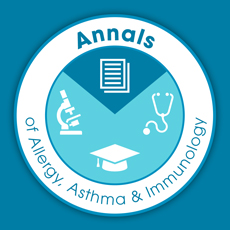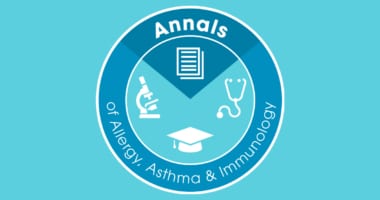 As we begin summer, I hope you take time to sit with a cool drink (or morning coffee) and peruse the pages of the June issue of the Annals of Allergy, Asthma and Immunology. As previously mentioned, the emphasis for this month is allergic skin diseases. However, in keeping with the Annals philosophy of “something for everyone in every issue,” I want to call your attention to two articles that should be useful to you in caring for patients who may not have allergic skin diseases.
As we begin summer, I hope you take time to sit with a cool drink (or morning coffee) and peruse the pages of the June issue of the Annals of Allergy, Asthma and Immunology. As previously mentioned, the emphasis for this month is allergic skin diseases. However, in keeping with the Annals philosophy of “something for everyone in every issue,” I want to call your attention to two articles that should be useful to you in caring for patients who may not have allergic skin diseases.
The first, authored by a highly regarded team of asthma clinicians and scientists led by Bradley Chipps, MD, FACAAI, College president, is the latest installment in the highly popular and useful “Yardstick” series. This one provides guidance for the more accurate diagnosis, assessment and management of children (from infancy through adolescence) with asthma. This will provide the reader with an in-depth assessment of when and how to step-up therapy for the child with inadequately controlled asthma. As part of the yardstick series, this paper presents patient profiles and step up/step down strategies based on current guidance documents as modified according to newer data, and the authors' combined clinical experience.
Another useful article reports on a study conducted by a national group of food allergy research experts led by Matthew Greenhawt, MD, MBS, MSc, FACAAI, from Denver. This study explored the attitudes and preferences of (mostly female) expectant and new caregivers of infants with eczema and egg allergy for early introduction of peanut within four to six months vs. after six months of age. From this well-conducted study, the authors conclude that there is poor current willingness and questionable support for early allergenic solid food recommendations. Willingness was best among expectant vs. new infant caregivers. The data suggest a significant gap exists between recommendations and adherence in families of these at-risk children. The authors present possible solutions to this enigma that may provide guidance to those of us who care for these infants and their families.
We look forward to bringing you more of these types of articles in future issues of the Annals and welcome feedback from our readers to identify topics of interest to you in your practice.

